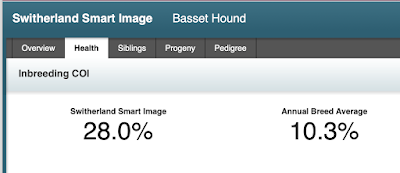A Bulldog called Thor has just won the National Dog Show in the USA. As the judge approached him before awarding the Best in Show crown, the judge's mic (so she must have heard it herself) picked up the rattle in his throat that likely points to an elongated soft palate. Two-hundred breeds, 2000 dogs and, ta-daaa, a respiratory cripple took the top spot.
© NBC clipped from here
Too strong? Here's Thor playing with a puppy at home, the obstruction obvious.
EDIT 3/12/12: This video was embedded from Facebook and its owner has now taken it down. It showed Thor playing with a puppy and I posted it because Thor's breathing was noisy/raspy.
This video is from around two years ago. Given that BOAS is a progressive condition, I am surprised that Thor was not noisier trotting round the National Dog Show ring but then the mic was not close to him most of the time and the crowd was loud.
Now Thor is actually better than most other Bulldogs we've seen in the US show-ring - he moves quite well (for a Bulldog), he has tight eyes and there are no obvious skin issues (although the judge did not lift his large nose roll to check). He's heavy but at least not grossly obese. He has terrible teeth compared to a normal dog, but they are better than most Bulldog teeth (you can, at least, see all six incisors even if they are higgledy-piggledy and largely buried in the gum).
Most Bulldog teeth look like this.
Thor has a very short, recessed screw tail (a mutation that we now know is associated with spine issues). The tail does not appear to be mobile, robbing him of that mode of expression, and it doesn't come anywhere close to covering his anus.
And that nose!! Tilted backwards under the large nose roll, Thor's nose is dry and dull and his nostrils are almost closed. Remember that dogs are as near-as-dammit obligate nose breathers.
And yeah.... that underbite... It's a demand in the breed standard; codified therein in the erroneous belief that, back-in-the-day, it better-equipped the Bulldog to hold on to a Bull. It leads, inevitably, to soft-tissue trauma in the mouth and a vastly elevated risk of periodontal disease because of cramped/rotated teeth and the mismatch between upper and lower jaws. I say it a lot but I will say it again... an underbite is a deformity (a Class 3 malocclusion in veterinary terms) and it has no place in a modern breed standard. Or, indeed, in a modern dog.
Thor has been quite extensively health-tested - and I'm genuinely pleased to see that he has good hips given that the Bulldog is the worst breed for hip dysplasia). This is a bit of progress. But you'll note that there is no result here for respiratory health and that's because despite poor breathing being the single biggest health issue for Bulldogs and other extreme brachycephalic breeds, there is no official scheme in the USA, unlike here in the UK, Scandinavia and an increasing number of countries in Europe.
To sum up, while Thor might be good for a Bulldog, he is a disaster for a dog and I despair that any judge could have chosen him over the other dogs (all with normal canine conformation) in the Best in Show ring. I mean, award him Best of Breed if you have to - but the Best dog overall?
Finally - a question to US vets and the American Veterinary Association:
Why are you not doing more to address brachycephalic health in the US? Why are you not even talking about it publicly when the Bulldog is now the 5th most popular dog in the US (and the French Bulldog - arguably even worse - is the 4th)?
Here in the UK, in Scandinavia and in parts of Europe, there is progress being made because veterinarians have stood up and said enough is enough.
US vets: your silence increasingly suggests tacit approval of the breeding of dogs that struggle to mate, whelp, breathe, thermo-regulate and are dead by, on average, six old. Please, please, please get more involved in shaping a healthier future for these dogs.
They need you.
EDIT 2/11/19
Several commenters below have suggested that the Bulldog with the bad breathing featured in the home video that was featured above is not Thor.
Here are some pictures which prove they are one and the same dog - on the left, stills from the home video, compared with, on the right, stills of Thor from the National Dog Show TV footage.
Join in on the brachycephalic debate on CRUFFA.































